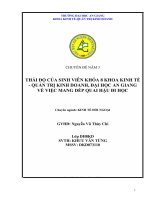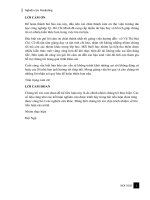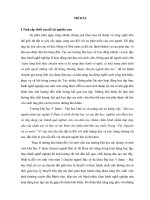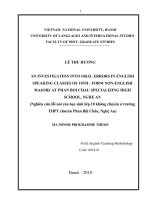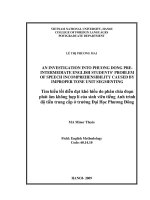Tìm hiểu lối diễn đạt khó hiểu do phân chia đoạn phát âm không hợp lý của sinh viên tiếng Anh trình độ tiền trung cấp ở Trường Đại học Phương Đông
Bạn đang xem bản rút gọn của tài liệu. Xem và tải ngay bản đầy đủ của tài liệu tại đây (1014.79 KB, 53 trang )
VIETNAM NATIONAL UNIVERSITY, HANOI
COLLEGE OF FOREIGN LANGUAGES
POSTGRADUATE DEPARTMENT
LÊ THỊ PHƢƠNG MAI
AN INVESTIGATION INTO PHUONG DONG PREINTERMEDIATE ENGLISH STUDENTS’ PROBLEM
OF SPEECH INCOMPREHENSIBILITY CAUSED BY
IMPROPER TONE UNIT SEGMENTING
Tìm hiểu lối diễn đạt khó hiểu do phân chia đoạn
phát âm khơng hợp lí của sinh viên tiếng Anh trình
độ tiền trung cấp ở trƣờng Đại Học Phƣơng Đông
MA Minor Thesis
Field: English Methodology
Code: 60.14.10
HANOI- 2009
VIETNAM NATIONAL UNIVERSITY, HANOI
COLLEGE OF FOREIGN LANGUAGES
POSTGRADUATE DEPARTMENT
LÊ THỊ PHƢƠNG MAI
AN INVESTIGATION INTO PHUONG DONG PREINTERMEDIATE ENGLISH STUDENTS’ PROBLEM
OF SPEECH INCOMPREHENSIBILITY CAUSED BY
IMPROPER TONE UNIT SEGMENTING
Tìm hiểu lối diễn đạt khó hiểu do phân chia đoạn
phát âm khơng hợp lí của sinh viên tiếng Anh trình
độ tiền trung cấp ở trƣờng Đại Học Phƣơng Đông
MA Minor Thesis
Field: English Methodology
Code: 60.14.10
Supervisor: Nguyễn Bách Thảo, MA
TABLE OF CONTENTS
DECLARATION…………………………………………………………..................... i
ACKNOWLEDGEMENT…………………………………………………………….. ii
ABSTRACT……………………………………………………………………………. iii
TABLE OF CONTENTS……………………………………………………………… iv
LIST OF CHARTS AND TABLES……………………………………….…………..vii
LIST OF ABBREVIATIONS……………………………………………....................viii
PART A: INTRODUCTION….………………………………………….................... 1
I.
Rationale……………………………………………………………………. 1
II.
Aims of the study……………………………………………………………. 2
III.
Scope of the study…………………………………………………………… 2
IV.
Methods of the study………………………………………………………… 3
V.
Design of the study………………………………………………………….. 3
PART B: DEVELOPMENT……………………………………………………………4
I.
LITERATURE REVIEW………………………………………….……....4
I.1. Definition of tone unit………………………………………….........................4
I.1.1. Different terms denoting a tone unit………………………........................4
I.1.2. Concept of tone unit and its phonological components…………………...5
I.1.3. Grammatical and Contextual characteristics of tone unit………………....7
I.2. Kinds of tone units…..………………………………………………………....9
I.3. Communicative function of tone units………………………………………11
I.4. Non-native learners’ problems with tone unit segmentation…………….. 12
II.
THE STUDY……………………………………………………………… 14
Chapter 1: Investigating students’ problem of speech incomprehensibility in relation to
improper tone unit segmenting……………................................................
15
CONTEXT OF THE STUDY………………………………….................
15
DATA COLLECTION PROCEDURE……………………….………..
15
The subjects………………………….......................................................
15
The instruments……………………………………………………….…..16
Oral test…………………………………………………………….…..16
Transcription and peer-evaluation of oral presentations………………
16
Questionnaires and interviews……………………………...................
16
DATA ANALYSIS……………………………………………….………....
17
Identifying the relation between students’ incomprehensible speech and their improper
tone unit segmenting………………………………………
17
Findings from oral tests, peer-evaluation and transcripts of students’
conversations and talks……………………………………………..……17
Seeking
Findings from the first part of the questionnaires and interviews …..…..19
causes
of
the
students’
problem
of
improper
segmentation…………………………..……………………………………
tone
unit
22
Findings of teachers’ observation………………………………..…… 22
Findings of the second part of the questionnaires and interviews……… 23
DISCUSSION OF THE DATA…………………………………………..
28
Chapter 2: Suggested solutions to the targeted students’ problem of improper tone unit
segmentation……………………………………….................................................
2.1.
Enhancing
teachers’
knowledge
and
awareness
of
31
tone
segmenting………………………………………………………………...31
2.2.
2.2.1.
Adjusting the teaching and learning procedure………….................... 31
Improving students’ level of proficiency and self-reliance……………31
unit
2.2.2.
Taking
advantage
of
speaking
tasks
for
training
tone
unit
segmentation………………………………………………………….. 32
2.2.3.
Perceiving native speakers’ ways of segmenting tone unit using tape
scripts……………………………………………………………..
2.2.4.
Providing students with knowledge of intonational
principles of tone units
adopting awareness-raising approach…………………………
2.2.5.
2.3.
33
35
Using peer and group-correction facilitated by visual aids………… 36
Adjusting the teaching curriculum and the materials…………………37
2.3.1.
Improving the teaching curriculum……………………………………37
2.3.2.
Supplying more materials…………………………………………….. 37
PART C: CONCLUSION…………………………………………………………….. 39
REFERENCES…………………………………………………………………………. I
Questionnaire for students……………………………………………………………. V
Questionnaire for teachers………………………………………………………….... VII
Peer-check evaluation sheet…………………………………………………………. X
LIST OF CHARTS AND TABLES
Chart 1: Difficulties the audiences had in understanding the speaker
Chart 2: Listeners’ misunderstanding partners’ speech by frequency
Chart 3: Teachers’ judgment on the audiences’ understanding of speakers’ speech
Chart 4: Knowledge of intonation vs. pronunciation
Chart 5: Places of students’ pauses
Chart 6: Formal instruction on tone unit segmentation given previously
Chart 7: Effectiveness of teachers’ lessons on tone units
Table 1: Possible reasons of incomprehensible speech on the speaker’s part
Table 2: Ways students did to make a good speech
Table 3: Ways of improving speech’s comprehensibility
2.2.2.
Taking
advantage
of
speaking
tasks
for
training
tone
unit
segmentation………………………………………………………….. 32
2.2.3.
Perceiving native speakers’ ways of segmenting tone unit using tape
scripts……………………………………………………………..
2.2.4.
Providing students with knowledge of intonational
principles of tone units
adopting awareness-raising approach…………………………
2.2.5.
2.3.
33
35
Using peer and group-correction facilitated by visual aids………… 36
Adjusting the teaching curriculum and the materials…………………37
2.3.1.
Improving the teaching curriculum……………………………………37
2.3.2.
Supplying more materials…………………………………………….. 37
PART C: CONCLUSION…………………………………………………………….. 39
REFERENCES…………………………………………………………………………. I
Questionnaire for students……………………………………………………………. V
Questionnaire for teachers………………………………………………………….... VII
Peer-check evaluation sheet…………………………………………………………. X
LIST OF CHARTS AND TABLES
Chart 1: Difficulties the audiences had in understanding the speaker
Chart 2: Listeners’ misunderstanding partners’ speech by frequency
Chart 3: Teachers’ judgment on the audiences’ understanding of speakers’ speech
Chart 4: Knowledge of intonation vs. pronunciation
Chart 5: Places of students’ pauses
Chart 6: Formal instruction on tone unit segmentation given previously
Chart 7: Effectiveness of teachers’ lessons on tone units
Table 1: Possible reasons of incomprehensible speech on the speaker’s part
Table 2: Ways students did to make a good speech
Table 3: Ways of improving speech’s comprehensibility
Table 4: Reasons for problems of improper tone unit segmenting
Table 5: Reasons for teachers’ failure in teaching tone unit segmentation
LIST OF ABBREVIATIONS
EFL: English as a foreign language
MA. Master of Arts
PART A: INTRODUCTION
I. Rationale
Nowadays English is so popular that it becomes a prerequisite means of regional and
international communication. Most of these interactions, which play as a stimulus for global
socio-economic relations and knowledge perception, are carried out orally. Therefore, spoken
English language as well as the comprehensibility of speech is of ultimate importance. In deed, as
stated by Richards, J.C. (2006): “The worldwide demand for English has created an enormous
demand for quality language teaching and language teaching materials and resources. Learners
set themselves demanding goals. They want to be able to master English to a high level of
accuracy and fluency”. However, when mastering English, a lot of learners have difficulty in
delivering comprehensible speech because of their problems with tone unit segmenting. In spite
of the fact that constant effort has been exhorted to renovate methods of teaching and learning
English intonation to the non-native, the achieved pedagogical measures are not practical and
specific enough to be utilized in all non-native environments. This hardship has not only been
experienced by Vietnamese learners but also by non-native speakers from other countries such as
China, Korea, Singapore, Spain… ( Hewings 1995; Goh 2001, Pickering 2001, Tao 2007). Over
decades, researchers on English intonation of the non-native focused on contrastive analysis
between native and non-native‟s preference of tone unit boundary, proposed the concepts of tone
unit and discussed its role in communication with a light weight on feasible strategies to deal
with the matter. Despite the fact that various studies on non-native problems of tone unit
segmenting are detected, Vietnamese researches about such important issue are hardly found.
As the case in a number of Vietnam universities, many students of English major at
Phuong Dong University have troubles in dividing tone units in conversations, oral presentations,
reports and even in reading aloud activity. Recently, I have been in charge of two groups of preintermediate students in their second year and I have found that they have great difficulty in tone
unit segmentation and often fail to make themselves understood, especially in natural speech.
Nonetheless, teachers as well as students do not realize the fundamental reasons for the situation.
They generally blame it on learners‟ low level of proficiency. As a result, the same circumstance
remains with the students in the coming terms when they‟re required to make longer and more
eloquent speech. Hence, it is time for Vietnamese teachers of English to concern about this
significant aspect to work out suitable solutions to the learners‟ problems in tone unit dividing.
II. Aims of the study
As a matter of fact, the objective of teaching English in the global era is not all about
traditional English grammar. Educators now focus much on comprehensibility in social
communication. In addition, the communicative and discourse function of intonation has been
remarkably highlighted (Celce-Murcia 1996; Jenkins 2004; Brazil 1985, 1997; Roach 2000, ext
from Tao 2007). Therefore, the segmentation of intonation units, one of crucial factors deciding
the meaning of speech, turns out to be quite necessary in learning and teaching English. Thus, I
determine to investigate into my students‟ problem of improper tone unit segmenting and aim at
working out some basic solutions to the problem. Hence, this thesis is not only useful to my own
Vietnamese students but also to whoever meet the same problems and share similar concern.
III. Scope of the study
As stated before, the research mainly concentrates on improper intonation unit
segmentation problem, leading to speech incomprehensibility of pre-intermediate English
majored students at Phuong Dong University. Regarding the markers of tone unit segmenting, the
study narrows down to pausing since it is linear and the most popular in the talk of the students.
IV. Methods of the study
With regard to the methodology, in the process of data collection, I used some
instruments namely oral tests (conversations and reading aloud), questionnaires, interviews,
observation of students‟ oral presentations, recording and note-taking. Therefore, I mainly used
qualitative method for data analysis and this is a survey research along with error analysis as I
worked on the issues basing on the findings from questionnaires as well as interviews of six
teachers and three groups of students (categorized according to level of proficiency) in two
classes of 40 students, combining with the results of the observation, peer-evaluation and
transcriptions. Finally, from these particular data, I will work out the causes of difficulties and
mistakes of Vietnamese students in tone unit segmenting and come up with relevant implications.
V. Design of the study
As for the design, the study comprises of three main parts:
First, the introduction clarifies the rationale, the aims, the scope, the method and the
design of the study. Second, the development includes two sections. Section I reviews the
previous studies on key concepts and theoretical background of tone units, tone unit segmentation
of the non-natives and claims two research questions. Section II is the study, the first chapter of
which presents the results of the survey, observation and transcripts as well as the discussion of
the findings. The second chapter proposes some basic solutions to the problems caused by
improper tone unit segmenting encountered by Phuong Dong pre-intermediate English learners.
Finally, the last part of the paper is the conclusion containing the summary of main arguments,
the conclusion, the limitation of the study and some suggestions for further research.
PART B: DEVELOPMENT
I. LITERATURE REVIEW
In this part, I am going to mention the definition of tone unit; its components,
characteristics and function in communication. The research, therefore, will present a variety of
views on tone unit‟s boundary and types of tone units in spontaneous speech. Furthermore, tone
unit choice is also driven by the interactive context which demands the involvement of discourse
intonation and communicative function of tone units. Last but not least, the rest of the section
will review important grounding materials of some common tone unit segmenting problems
experienced by non-native speakers.
I.1. Definition of tone unit
I.1.1. Different terms denoting a tone unit
There are many names which are synonymous with the term „tone unit‟. Before actually
defining the concept „tone unit‟, it might be useful to identify this prosodic stretch by mentioning
the identical terms adopted by different experts following various approaches.
It has long been recognized that spoken language organizes itself in segments of speech.
This segmented stretch mainly relates to tone or intonation, and has therefore been termed „tone
group‟, „intonation group‟, „tone unit‟, „intonation(al) phrase‟, intonation unit‟, or the like. ( e.g
Beckman & Pierrehumbert 1986; Halliday 1989; Selkirk 1984; Chafe 1994; Cruttenden 1997;
Brazil 1997; Hirst & Di Cristo 1998; Halliday 2004). Whatever terms or approach is taken, it
seems that there is a wide consensus that the intonation unit encapsulates a functional, coherent
segmental unit, be it syntactic, semantic and informational.
In deed, in natural speech, utterances are produced in chunks. This chunk has been
identified variously as „tone unit‟, „breath group‟, „intonation group‟ and „intonation unit‟. The
study adopts the term „tone unit‟ (Crystal, 1969) because it reveals the internal structure of the
segment.
As regards the markers of tone units, this utterance chunk is often accompanied by
prosodic features, such as initial pitch reset, final vowel lengthening, initial or post pauses, and
steady declination in pitch over time (Cruttenden 1997, Hirst&Di Cristo 1998).
I.1.2. Concept of tone unit and its phonological components
According to Chafe (1987), a tone unit is a prosodic unit in natural discourse, which is
defined as any speech segment that falls into a single coherent contour, and is sometimes
separated by pauses at the beginning and the end. In addition, as for Timkova‟s explanation
(2001), phonologically, each tone unit comprises only one nucleus, the most prominent syllable
of the individual tone groups. And stress placement plays the most important role in the
development of the melody contours.
For example, the expression: //Give him a hand with that// is a good illustration of a
complete melody contour. “hand” is the head or the most prominent syllable of this tone unit
marked by two slashes // at the two ends.
( />
Alharbi(2004) when denoting the internal criteria of a tone unit, supposed that “each
intonation group is made up minimally of a syllable, which carries a pitch movement of some
sort (a glide or a jump)”. The active change of pitch, which is referred to by Crystal as 'nucleus'
and by Halliday as „tonic,‟ is a mandatory element of an intonation group. The presence of the
nucleus is identified on two grounds. Physically, the nucleus takes the form of an observable
change of fundamental frequency (pitch), i.e., the change in the rate of vibration of the vocal
cords. Functionally, in each intonation group there is one and only one peak of prominence in the
form of a major pitch change. In Brazil‟s view point, each tone unit has either one or two
syllables that a hearer can recognize as being in some sense more emphatic than others…He
added: “ At first sight, the distribution of prominent syllables is determined by the lexis and
grammar of the utterance”. After that, from the analysis of recorded samples, he pointed out that
“the speaker has a freedom to vary the number of prominent syllables.”(1997:7-8)
For example, the passage below shows the freedom of choosing prominent syllables
without much consideration of grammar or lexical basis:
//we HAVE to reMEMber//THAT//they‟re reQUIRED/by adMINistrative PRACtice//to
TAKE these deCISions//on PAper//AND//MOST OFten// when they GET these decision//on
WRONG//it‟s beCAUSE// they HAVEn‟t had the opporTUNity//of TALKing//FACE to
FACE//WITH the CLAIMant//and REALly FINDing//the FACTS// (Brazil 1997, 8)
Tench( 1996) gave his definition of neutral tonality or tone unit system. To him, each
neutral tone unit “contains one piece of information-as the speaker perceives it…the subject
represents the theme-what the message is about; the predicate represents the rheme-what the
message actually is.” For instance, the syntax of : //A dog is a man’s best friend// : tells us what
the theme is, i.e. the subject of the clause, a dog; and then tells what the actual message is, i.e. the
predicate, is a man’s best friend( the „rhemme‟) ( Tench 1996, 32). He also commented: “the
concept…is a very useful starting-point. It embraces a very important point: the functional
equivalence of intonation unit, clause and unit of information, linking up phonology with
grammar and semantics.”
Furthermore, in many other researches, it is a common consensus that tone unit is the
smallest block of meaningful speech, which is comparable to smallest syntactic units. Therefore,
tone units have both syntactic and functional structures. Iwasaki (1993), a Japanese researcher,
drew attention to the multi-faces of tone units. Now that syntactically, tone units may correspond
to a clause, phrase, or lexical item. Functionally, they express ideational content, textural
coherence, interpersonal concerns, and other aspects of communication.
I.1.3. Grammatical and contextual characteristics of tone unit
I.1.3.1. Grammatical aspect of tone units
According to Brazil (1997), tone unit segmenting is first decided with a view to
grammatical basis. In deed, many studies which investigated the relation between grammar or
syntax and tone unit concluded that the preliminary foundation of tone unit was its structure or
grammatical characteristics marked by punctuation or syntactical boundary in written form and
by pauses and other phonological realizations in spoken form.
Tench( 1996) proposed a quite sufficient background of tone units with reference to
different linguistic characteristics. Cases of tone unit segmenting presented in his book: “The
Intonation Systems of English” were classified according to information value and linguistic
features. Most of these linguistic means of dividing tone units were linguistic functions of the
units within the discourse. For examples, tone units may be quite short in case of lists, tags,
apposition, adjuncts…and quite long in case of main clauses.
Also, about the tone unit boundary, many research findings show that clauses are most
basic and popular unit associating with tone units. Halliday (1989) whose work has had a
significant impact on wide linguistic circles promoted the use of the clause as the basic unit of
spoken language. Also, in a well-known paper, Chafe (1987: 38) concluded: “The clause appears
to be the prototypical intonation unit type, from which most other types are derived, or are
derivations”. From Chafe‟s findings, clauses and substantive tone units coincide by 60% (Chafe
1994), the question was raised concerning the centrality of the clause in the study of spoken
language. Several studies took a similar path of exploration, basing on the premise that the tone
unit is the basic unit of conversational language, checking the constituency of tone units in terms
of clauses and NPs and mapping clauses into tone units. These studies covered a range of
languages: English; Mandarin Chinese, Japanese, Finish, Wardaman (Australian), Sasak
(Western Astronesian) (Iwasaki & Tao 1993; Croft 1995; Tao 1996; Helasvuo 2001; Matsumoto
2003; Croft 2005). It seems that most authors are happy with the notion of clause as a valid
category for the study of spontaneous, conversational language, either in its most expanded
structure or in a reduced form, such as the predicate and its core arguments (Croft 1995; 2005;
Helasvuo 2001; cf. Du Bois 1987 for the strategy of preferred argument structure). Tench (1996)
reviewed from Tench(1990:41-43) and Quirk( 1964) that in one count, 916 tone units, out of
1,880 in the whole data, correspond to complete clauses-almost over 50 percent.
On the other hand, having worked on the data whose subjects were Asian speakers, Tao
and Iwasaki (1993) have found that natural speeches of Mandarin and Japanese speakers of
English contained a relatively large number of tone units consisting of Noun Phrases.
Furthermore, from many thorough researches, Tench (1996) gave a full picture of those cases
where intonation do not coincide with whole clauses by defining the concept: “marked tonality”
as any case that does not correspond to neutral tonality, occurs either when two (or more) clauses
fit into a single tone unit, or when-and this is much more frequently the case-two (or more) tone
units are needed to cover a single clause.
I.1.3.2. Contextual aspect of tone units
In theory, tone unit is defined mechanically according to its structure or functions.
However, in natural continuous speech, tone units are manageable chunks, which have a lot of
variables influenced considerably by the context among speakers and listeners. The factors of
context can be the shared knowledge, the new information, the intention, the background and
even the relation of the interlocutors within the surrounding environment. Therefore, tone unit
would not be fully recognized without considering its contextual basis. According to Brazil
(1994), each tone unit represents a further increment of shared contextual understanding along
the stream of speech and embodies moment-by-moment and ongoing functional choices
regarding that language deemed most salient. In other words, tone unit division depends much on
the grammatical, phonological foundation and finally decided by the contextual facet of the
interactive speech. The choice of tone units as phrases, clauses, sentences or smaller units reflects
the given or new information, the environment and the characteristics of the interlocutors rather
than driven by forms, structures and punctuations. This is termed context-specific choices (Brazil,
1994).
A concluding remark
From the above definitions and analysis, a tone unit can be understood as a smallest
meaningful block of speech, the basic prosodic-syntactical unit of language in its spoken medium
(Amir, Varod & Izre‟el, nd). Syntactically, it may be equivalent to a contextually pmeaningful
lexical item, phrase or clause which in turn communicates an event or a meaning. Even though
most researchers approved that clause was the most frequent unit associated with tone unit, the
choices of clauses or phrases as tone unit segments can be variable depending on the
interlocutors‟ characteristics and their intention.
I.2. Kinds of tone units
There are some kinds of tone units which are considered to be the basic units of discourse.
Chafe (1994) distinguishes between fragmentary, substantive, and regulatory tone units.
Fragmentary tone units are those that have not come to a successful end. Fragmentary units are
precisely that: false starts or units cut off by another speaker. Substantive tone units are those
that convey ideas and events, states or referents. It is in substantive intonation units that the role
of consciousness is most apparent in that the cognitive processes that mark givenness, newness
and accessibility have their domain (Chafe 1994, pp. 63-64). Regulatory tone units are those
whose function is the regulation of information flow or interaction between speakers. Regulatory
units are of four types: (a) textual, e.g., “and then” and “well”; (b) interactional, e.g., “mhm” and
“you know”; (c) cognitive, e.g., “let me see,” and “oh”; and (d) validational, e.g., “maybe” and “I
think”… Broderick (2001).
Broderick (2001) gave us some examples from his transcriptions:
Fragmentary Tone Unit , Regulatory ToneUnit, Substantive Tone Unit
a
0:02.6
Wéll.( Regulatory)
b
0:02.7
I‟ve got twò things plánned for you.(substantive)
c
0:04.8
.. this mórning,
d
0:05.4
...(0.3) Úm-----------------(fragmentary)
e
0:06.2
...(0.5) While we are wàiting for the óthers,
f
0:08.0
in càse they dó come,
g
0:09.0
tell me whàt you‟re going to do this wéekend.
h
0:10.5
…(3.0) It‟s alrèady stárting now.
j
0:15.0
...(1.0) Wátcha gonna do,
k
0:16.8
...(0.7) Do you have any pláns?
Likewise, according to some materials, for American English, three major categories of
transitional continuity have been suggested via tone units, mainly suggesting interaction between
the interlocutors: terminal, continuing and appeal. These are categorized in terms of discourse
structure and information structure.
Tench (1996) clarifies two main types of tone units which are neutral tone units and
marked tone units. A neutral tone unit is equivalent to a clause, expressing a complete piece of
information while a marked tone unit is smaller or bigger than a clause, expressing a special
intention of the speaker
For example (Tench 1996, 34-40):
Neutral tone units: //I am going into town this morning//
Marked tone units:
//I am going into town// this morning//
//The man dressed in black//(then stood up)
//The man//dressed in black//(then stood up)
And as mentioned before, the major perceptual and acoustic cues of boundary recognition
for realizing these types of tone units are: final lengthening, initial rush, pitch reset and pause (
Cruttenden 1997, Hirst&Di Cristo 1998).
I.3. Communicative function of tone units
Discussing the communicative functions of tone unit, Joseph Sung Park from the
University of California (2000) proposed that tone unit could be used as an interactional resource,
which participants used in meeting their interactional needs. Similarly, Ford, Fox and Thompson
(1996) and Selting (2000) showed that tone units played a crucial role in turn-taking in
conversation by projecting turn completion through prosody. Brazil‟s study of tone unit also
emphasized the communicative value of tone unit as he pointed out that each tone unit in the
stream of speech was the understanding and communicative choices of interlocutors within
shared context timed moment by moment, without being fixed by factors of grammar or
formulaic patterns. (Brazil 1997)
Providing us with a good illustration, Brown (1977: 88), observed that the difference
between restrictive and non-restrictive relative clauses which denote the new and old information
may be marked by tone group division in slow, formal speech.
Pike (1972: 56) stated the communicative importance of intonation very vividly in the
following words:
Actually, we often react more violently to the intonational meanings than to the lexical
ones; if a man’s tone of voice belies his words, we immediately assume that the
intonation more faithfully reflects his true linguistic intentions.
Also commenting on the communicative importance of intonation and tone units, Gimson
(1980: 264) described changes in intonation as “the most efficient means of rendering prominent
for a listener, those parts of an utterance on which the speaker wishes to concentrate attention”.
I.4. Non-native learners’ problems with tone unit segmentation
For non-native speakers, intonation is a great challenge as they are not familiar with the
intonational system and partially because they do not have many chances to communicate with
the natives. This is also because of transference of the mother tongue (Timkova‟(2000)).
Therefore, when cross-cultural communication occurs, they often fail to gain success. For
example, the Slovak learners sound monotonous and produce very long utterance without any
turn of intonation. As regards Asian speakers like the Thai, Japanese and Chinese, their misuse of
tone unit cause them a lot of problems. According to Tao( 2007), local learners of medium level
face huge difficulty in dividing tone units, which leads to misunderstanding and communication
failure since what they say are not comprehensible to listeners. For instance, Chinese learners use
phrasal tone units more often and they pause too frequently and do not pause at appropriate
junctures. For example: I was speaking to//him on the//phone yesterday. In deed, Gilbert (1987)
showed that pausing in different places could make a change in meaning as it caused ambiguity:
Ex: Who is stupid?
1 Afred said//the boss is stupid
2 Afred//said the boss//is stupid
Not surprisingly, the intonation of non-native English poses serious intelligibility
problems to native speakers of the language, as reported by Tiffen (1974) on Nigerian English
and Bansal (1976) on Indian English. Bansal(1976) reveals the misuse of sentence stress and
intonation in Indian English:
“The sentence stress in Indian English is not always in accordance with the normal RP
pattern and the characteristic rhythm is not maintained. The division of speech into sense
groups and tone groups is sometimes faulty, and pauses are made at wrong places. The
location of the intonation nucleus is not always at the place where it would be in normal
English. The rising tone sometimes used at the end of statements must sound unusual to
the RP-speaking listeners”
Furthermore, the above researchers have found that the reasons behind this
inappropriateness of tone unit segmenting are learners‟ low level and the lack of materials and
official researches about the area. Atoye (2004), while reviewing researches on intonation
problems of Nigerian speakers of English, came to a concluding remark that, intonation-a part of
supra-segmental features is exclusive from English classroom and scientific research. Tao (2007)
and Atoye(2004) also criticized the application of structural English teaching methods instead of
communicative ones in giving lectures on phonology. Wang (2003) stated that the difficulties of
Chinese students in intonation acquisition were worsened by the thought that intonation was not
as practical as writing and reading because learners only communicated in English classroom. In
addition, Wang found that the teaching materials and teachers‟ knowledge of intonation were not
sufficient for delivering intonational lessons.
Likewise, a lot of Vietnamese learners of English encounter the same problems. However,
there is a lack of practical implications to solve these students‟ comprehensible problem caused
by improper tone unit segmentation. Thus, this study is carried out to find the answer to two
research questions:
1. Is there a relation between Phuong Dong pre-intermediate students’ improper tone unit
segmenting and their speech incomprehensibility?
2. What are the solutions to the targeted students’ problem of improper tone unit
segmenting in order to improve their speech comprehensibility?
II. THE STUDY
This part describes the context of the study, reveals the data collection procedure as well as the
results of data analysis process, which identifies the students‟ incomprehensibility problem
caused by improper tone unit segmenting. Then, the causes of students‟ improper tone unit
segmentation are investigated. Finally, it proposes some practical solutions to the matters basing
on the findings of the study.
CHAPTER 1
INVESTIGATING STUDENTS’ PROBLEM OF SPEECH INCOMPREHENSIBILITY IN
RELATION TO IMPROPER TONE UNIT SEGMENTING
1.1. CONTEXT OF THE STUDY
The research was carried out in a non-native English environment where students hardly
had chances to communicate with native speakers to adopt a native-like intonation. However,
pronunciation, since 2008, has been paid much attention to and started as an independent course
